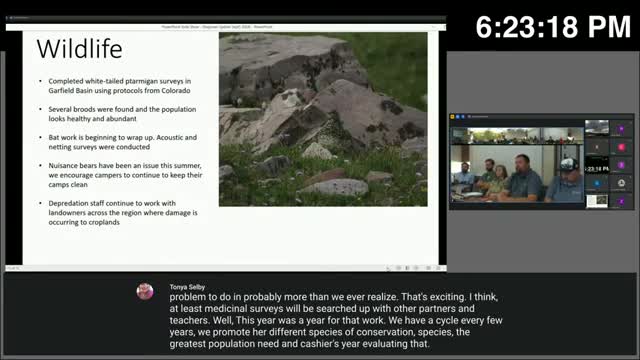Wildlife officials tackle illegal species introduction crisis
September 06, 2024 | Natural Resources Department, Utah Environment, State Agencies, Organizations, Utah Executive Branch, Utah
This article was created by AI summarizing key points discussed. AI makes mistakes, so for full details and context, please refer to the video of the full meeting. Please report any errors so we can fix them. Report an error »

In a recent government meeting, wildlife officials discussed various pressing issues concerning local ecosystems and species management. The meeting highlighted two primary methods for monitoring bat populations: deploying acoustic recorders to identify species and conducting field surveys near water sources. Officials noted the presence of invasive bat species, emphasizing the need for public awareness and engagement in conservation efforts.
Additionally, the meeting addressed the increasing bear population and the importance of educating campers about bear behavior, particularly as bears prepare for winter by consuming more food. Officials encouraged the public to adhere to safety guidelines to minimize human-wildlife conflicts.
Trent Hedrick, coordinator for the division of wildlife, reported on the illegal introduction of a wild fish species at Strawberry Reservoir. Following a December incident, the division has initiated eDNA sampling and is actively seeking public reports of any unusual fish catches. Hedrick expressed optimism about the situation, noting no further illegal introductions have been reported, while also acknowledging the need for a strategic approach to prevent future occurrences.
The meeting also covered upcoming fishery regulations for 2025, which are part of an adaptive management strategy aimed at maintaining angler satisfaction and achieving specific management objectives. Officials outlined the extensive data collection and analysis process that informs these regulations, underscoring the importance of ongoing monitoring to ensure the health of local fish populations.
Overall, the discussions underscored the challenges faced by wildlife management in the region and the collaborative efforts required to address these issues effectively.
Additionally, the meeting addressed the increasing bear population and the importance of educating campers about bear behavior, particularly as bears prepare for winter by consuming more food. Officials encouraged the public to adhere to safety guidelines to minimize human-wildlife conflicts.
Trent Hedrick, coordinator for the division of wildlife, reported on the illegal introduction of a wild fish species at Strawberry Reservoir. Following a December incident, the division has initiated eDNA sampling and is actively seeking public reports of any unusual fish catches. Hedrick expressed optimism about the situation, noting no further illegal introductions have been reported, while also acknowledging the need for a strategic approach to prevent future occurrences.
The meeting also covered upcoming fishery regulations for 2025, which are part of an adaptive management strategy aimed at maintaining angler satisfaction and achieving specific management objectives. Officials outlined the extensive data collection and analysis process that informs these regulations, underscoring the importance of ongoing monitoring to ensure the health of local fish populations.
Overall, the discussions underscored the challenges faced by wildlife management in the region and the collaborative efforts required to address these issues effectively.
View full meeting
This article is based on a recent meeting—watch the full video and explore the complete transcript for deeper insights into the discussion.
View full meeting

